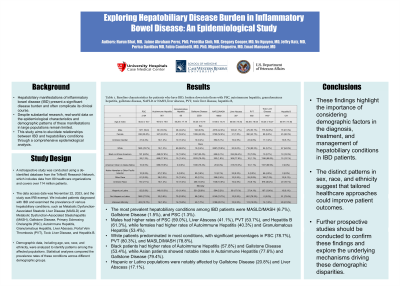Monday Poster Session
Category: IBD
P2593 - Exploring Hepatobiliary Disease Burden in Inflammatory Bowel Disease: An Epidemiological Study
Monday, October 28, 2024
10:30 AM - 4:00 PM ET
Location: Exhibit Hall E

Has Audio

Harun Bhat, MD
University Hospitals Cleveland Medical Center, Case Western Reserve University
Cleveland, OH
Presenting Author(s)
Harun Bhat, MD1, Jaime A. Perez, PhD2, Preetika Sinh, MD3, Gregory Cooper, MD4, Vu Q. Nguyen, MD, MS4, Jeffry Katz, MD4, Perica Davitkov, MD3, Fabio Cominelli, MD, PhD4, Miguel D Regueiro, MD5, Emad Mansoor, MD4
1University Hospitals Cleveland Medical Center, Case Western Reserve University, Cleveland, OH; 2University Hospitals Clinical Research Center, Cleveland, OH; 3University Hospitals Cleveland Medical Center, Cleveland, OH; 4Digestive Health Institute, University Hospitals Cleveland Medical Center, Cleveland, OH; 5Cleveland Clinic, Cleveland, OH
Introduction: Hepatobiliary manifestations of inflammatory bowel disease (IBD) present a significant disease burden and often complicate its clinical course. Despite substantial research, real-world data on the epidemiological characteristics and demographic patterns of these manifestations in large populations remain limited. This study aims to elucidate relationships between IBD and hepatobiliary conditions through a comprehensive epidemiological analysis.
Methods: A retrospective study was conducted using a de-identified database from the TriNetX Research Network, which includes data from 89 healthcare organizations and covers over 114 million patients. The data access date was November 22, 2023, and the study was IRB exempt. We included patients diagnosed with IBD and examined the prevalence of various hepatobiliary conditions, such as Metabolic Dysfunction-Associated Steatotic Liver Disease (MASLD) and Metabolic Dysfunction-Associated Steatohepatitis (MASH), Gallstone Disease, Primary Sclerosing Cholangitis (PSC), Autoimmune Hepatitis, Granulomatous Hepatitis, Liver Abscess, Portal Vein Thrombosis (PVT), Toxic Liver Disease, and Hepatitis B. Demographic data, including age, sex, race, and ethnicity, were analyzed to identify patterns among the affected populations. Statistical analyses compared the prevalence rates of these conditions across different demographic groups.
Results: The most prevalent hepatobiliary conditions among IBD patients were MASLD/MASH (6.7%), Gallstone Disease (1.5%), and PSC (1.3%). Males had higher rates of PSC (59.0%), Liver Abscess (41.1%), PVT (53.7%), and Hepatitis B (61.3%), while females had higher rates of Autoimmune Hepatitis (40.3%) and Granulomatous Hepatitis (53.4%). White patients predominated in most conditions, with significant percentages in PSC (78.7%), PVT (80.3%), and MASLD/MASH (78.8%). Black patients had higher rates of Autoimmune Hepatitis (57.8%) and Gallstone Disease (53.4%), while Asian patients showed notable rates in Autoimmune Hepatitis (77.6%) and Gallstone Disease (79.4%). Hispanic or Latino populations were notably affected by Gallstone Disease (20.8%) and Liver Abscess (17.1%).
Discussion: The findings highlight significant demographic disparities in hepatobiliary manifestations among IBD patients, suggesting the need for tailored healthcare approaches. Further prospective studies should explore the mechanisms driving these disparities and validate the findings.
Disclosures:
Harun Bhat, MD1, Jaime A. Perez, PhD2, Preetika Sinh, MD3, Gregory Cooper, MD4, Vu Q. Nguyen, MD, MS4, Jeffry Katz, MD4, Perica Davitkov, MD3, Fabio Cominelli, MD, PhD4, Miguel D Regueiro, MD5, Emad Mansoor, MD4. P2593 - Exploring Hepatobiliary Disease Burden in Inflammatory Bowel Disease: An Epidemiological Study, ACG 2024 Annual Scientific Meeting Abstracts. Philadelphia, PA: American College of Gastroenterology.
1University Hospitals Cleveland Medical Center, Case Western Reserve University, Cleveland, OH; 2University Hospitals Clinical Research Center, Cleveland, OH; 3University Hospitals Cleveland Medical Center, Cleveland, OH; 4Digestive Health Institute, University Hospitals Cleveland Medical Center, Cleveland, OH; 5Cleveland Clinic, Cleveland, OH
Introduction: Hepatobiliary manifestations of inflammatory bowel disease (IBD) present a significant disease burden and often complicate its clinical course. Despite substantial research, real-world data on the epidemiological characteristics and demographic patterns of these manifestations in large populations remain limited. This study aims to elucidate relationships between IBD and hepatobiliary conditions through a comprehensive epidemiological analysis.
Methods: A retrospective study was conducted using a de-identified database from the TriNetX Research Network, which includes data from 89 healthcare organizations and covers over 114 million patients. The data access date was November 22, 2023, and the study was IRB exempt. We included patients diagnosed with IBD and examined the prevalence of various hepatobiliary conditions, such as Metabolic Dysfunction-Associated Steatotic Liver Disease (MASLD) and Metabolic Dysfunction-Associated Steatohepatitis (MASH), Gallstone Disease, Primary Sclerosing Cholangitis (PSC), Autoimmune Hepatitis, Granulomatous Hepatitis, Liver Abscess, Portal Vein Thrombosis (PVT), Toxic Liver Disease, and Hepatitis B. Demographic data, including age, sex, race, and ethnicity, were analyzed to identify patterns among the affected populations. Statistical analyses compared the prevalence rates of these conditions across different demographic groups.
Results: The most prevalent hepatobiliary conditions among IBD patients were MASLD/MASH (6.7%), Gallstone Disease (1.5%), and PSC (1.3%). Males had higher rates of PSC (59.0%), Liver Abscess (41.1%), PVT (53.7%), and Hepatitis B (61.3%), while females had higher rates of Autoimmune Hepatitis (40.3%) and Granulomatous Hepatitis (53.4%). White patients predominated in most conditions, with significant percentages in PSC (78.7%), PVT (80.3%), and MASLD/MASH (78.8%). Black patients had higher rates of Autoimmune Hepatitis (57.8%) and Gallstone Disease (53.4%), while Asian patients showed notable rates in Autoimmune Hepatitis (77.6%) and Gallstone Disease (79.4%). Hispanic or Latino populations were notably affected by Gallstone Disease (20.8%) and Liver Abscess (17.1%).
Discussion: The findings highlight significant demographic disparities in hepatobiliary manifestations among IBD patients, suggesting the need for tailored healthcare approaches. Further prospective studies should explore the mechanisms driving these disparities and validate the findings.
Disclosures:
Harun Bhat indicated no relevant financial relationships.
Jaime Perez indicated no relevant financial relationships.
Preetika Sinh indicated no relevant financial relationships.
Gregory Cooper indicated no relevant financial relationships.
Vu Nguyen: AbbVie – Speakers Bureau. Eli Lilly – Speakers Bureau.
Jeffry Katz indicated no relevant financial relationships.
Perica Davitkov indicated no relevant financial relationships.
Fabio Cominelli indicated no relevant financial relationships.
Miguel D Regueiro: AbbVie – Advisory Committee/Board Member, Consultant, Speakers Bureau.
Emad Mansoor: Lilly – Speakers Bureau. Takeda – Speakers Bureau.
Harun Bhat, MD1, Jaime A. Perez, PhD2, Preetika Sinh, MD3, Gregory Cooper, MD4, Vu Q. Nguyen, MD, MS4, Jeffry Katz, MD4, Perica Davitkov, MD3, Fabio Cominelli, MD, PhD4, Miguel D Regueiro, MD5, Emad Mansoor, MD4. P2593 - Exploring Hepatobiliary Disease Burden in Inflammatory Bowel Disease: An Epidemiological Study, ACG 2024 Annual Scientific Meeting Abstracts. Philadelphia, PA: American College of Gastroenterology.
